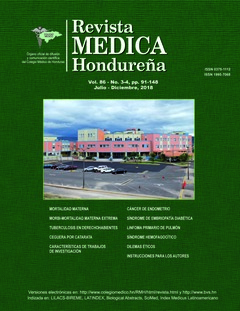Perfil clínico-epidemiológico de los derechohabientes con tuberculosis del IHSS, Tegucigalpa; periodo 2011-2016
DOI:
https://doi.org/10.5377/rmh.v86i3-4.12172Palabras clave:
Honduras, Ocupaciones, Seguro social, TuberculosisResumen
Antecedentes: Las condiciones laborales de ciertas personas pueden favorecer la aparición de tuberculosis. Objetivo. Determinar la existencia de patrones ocupacionales entre derechohabientes con tuberculosis (TB), del Instituto Hondureño de Seguridad Social (IHSS) en Tegucigalpa y resultado del abordaje diagnóstico y tratamiento. Metodología. Estudio descriptivo, retrospectivo, en los derechohabientes del IHSS Tegucigalpa, con universo de 460,150; la muestra fueron todos los expedientes de personas con Tuberculosis del periodo 2011-2016 mayores de 18 años. Se obtuvo información de la base de datos, fichas de notificación, expediente clínico y libro de seguimiento, determinando ocupación, variables sociodemográficas y programáticas. Se analizaron frecuencias e intervalos de confianza utilizando Epi Info Versión 7.2. Se solicitó permiso al IHSS y se respetó la confidencialidad de datos. Resultados. Se encontró expedientes de 214 pacientes con tuberculosis siendo mujeres (113) 52.6% y hombres (101) 47.4%; (137) 64% presentaron tuberculosis pulmonar y (77) 36% con tuberculosis extrapulmonar. La situación laboral predominante fue la de los asalariados de ocupación no especificada (73/214) 34%, seguido de Jubilados (16/214) 7%, empleados de salud (12/214) 6%, vigilantes (5/214) 2% y empleados de maquila (5/214) 2%. El método diagnóstico más frecuente fue baciloscopia (127) 59%, tuvieron éxito de tratamiento (171) 80%, fallecieron (13) 6%, perdida de seguimiento (13) 6%. Conclusión Es necesario diseñar estrategias de prevención y capacitación para diagnóstico y tratamiento oportuno en lugares de trabajo como compañías de vigilancia, maquila, escuelas y universidades, hospitales e investigar razones de excedo de fallecimientos y perdida de seguimiento de pacientes.
Descargas
281




